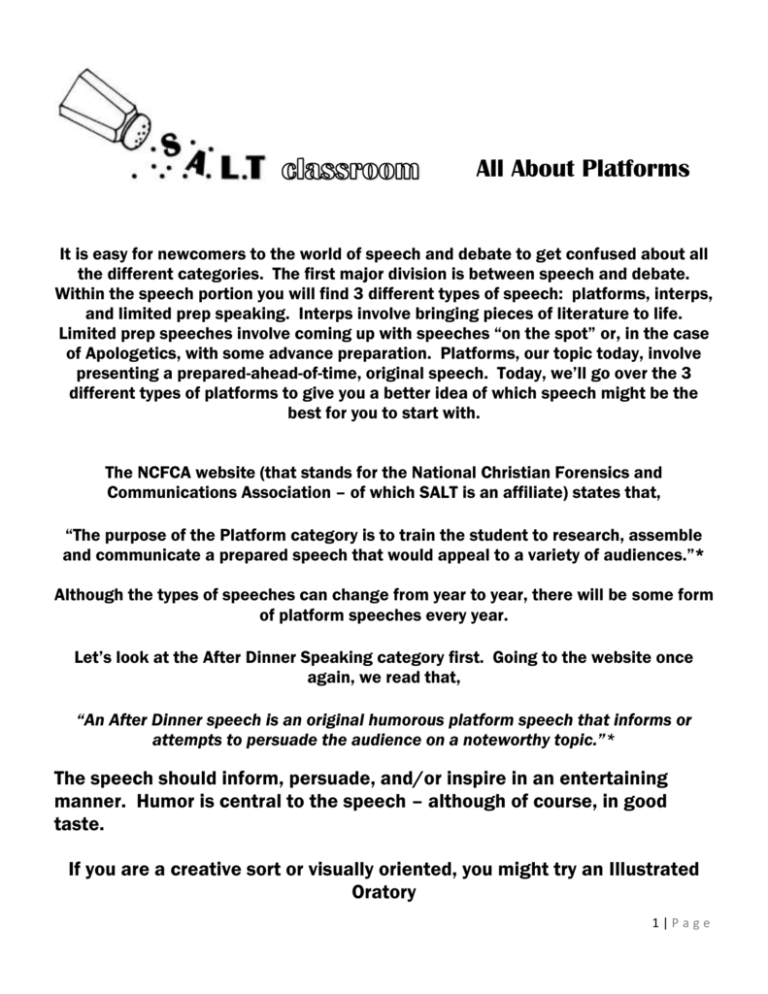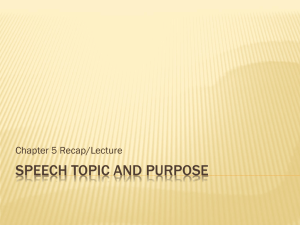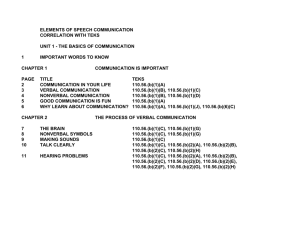File
advertisement

All About Platforms
It is easy for newcomers to the world of speech and debate to get confused about all
the different categories. The first major division is between speech and debate.
Within the speech portion you will find 3 different types of speech: platforms, interps,
and limited prep speaking. Interps involve bringing pieces of literature to life.
Limited prep speeches involve coming up with speeches “on the spot” or, in the case
of Apologetics, with some advance preparation. Platforms, our topic today, involve
presenting a prepared-ahead-of-time, original speech. Today, we’ll go over the 3
different types of platforms to give you a better idea of which speech might be the
best for you to start with.
The NCFCA website (that stands for the National Christian Forensics and
Communications Association – of which SALT is an affiliate) states that,
“The purpose of the Platform category is to train the student to research, assemble
and communicate a prepared speech that would appeal to a variety of audiences.”*
Although the types of speeches can change from year to year, there will be some form
of platform speeches every year.
Let’s look at the After Dinner Speaking category first. Going to the website once
again, we read that,
“An After Dinner speech is an original humorous platform speech that informs or
attempts to persuade the audience on a noteworthy topic.”*
The speech should inform, persuade, and/or inspire in an entertaining
manner. Humor is central to the speech – although of course, in good
taste.
If you are a creative sort or visually oriented, you might try an Illustrated
Oratory
1|Page
The NCFCA website explains,
“The Illustrated Oratory speech is an original platform speech which informs or
explains a particular topic with the use of visual aids. The Illustrated Oratory
speech should inform or explain a topic of the speaker’”*
At tournaments there are often first-time competitors and many 7th graders doing
IO’s. The boards can be a nice way to help remember speeches and guide the
speaker along.
Recent IO subjects: Illusions, Lawns, Memory, Healthier Fast Food Choices, Water
Bottles, Fear, Muslim Brotherhood, Shoes
The primary visual aids allowed are 3 to 10 illustrated boards measuring no larger
than 20 inches by 30 inches. Board flaps or other mounted material may not extend
beyond the 20 by 30 inch measurement of the boards. The standard easel used to
hold the boards may be modified to provide a ledge on the front and a mounting
system on the back.
If additional visual aids are used, they must fit completely in a lidded box (overall
dimensions of 35 inches or smaller {L+W+H = overall dimensions}). This box may be
attached to the back of the easel. The box is required to be present at the
tournament, but not required to be in the competition room.
The speaker must begin and end the speech with only a blank board visible to the
judges. The additional visual aids do not have to be in the box as the competitor
enters and leaves the room, but all visual aids must be out of sight of the judges
before the speech starts and by the time the speech ends. Any additional visual aids
attached to the boards during the speech can remain on the board, provided only a
blank board is visible to the judges by the time the speech ends.
Published works used as board illustrations must be cited on the same side of the
board as the illustration, and placed on or near the illustration. Citations need to be
easily visible.
One of the electives in an upcoming meeting will be how to have great IO boards. If
you are planning to compete in this category – try not to miss it. You will see several
examples of boards used in the past that have done well in competition.
2|Page
Next, we’ll look at the Persuasive category.
The NCFCA website states:
“A Persuasive Speech is an original speech that attempts to persuade the audience to
adopt a particular point of view or course of action.”*
Let’s face it, you are all pretty good at this category all ready. Hardly a day goes by
where you are not trying to persuade your parents to see things your way – what you’d
like for dinner, how it’d make sense for you to stay up late to watch that show, why
you should be able to study a few more days before the test.
Now, you can put those good skills to use. Find something you really care about and
use your platform to convince others to see things your way. You will be surprised to
find that you really can persuade people to make changes.
Recent Persuasive subjects: Why you should grow up, Why you should breathe deep,
Why you should support the heartbeat bill, Why we should look inside for beauty and
Why you should vote.
Obviously, convincing supports are needed in these speeches, as well as spending
time overcoming objections. Judges often look for what the subject means to you.
Personal connections to the topic make the plea for action more powerful – tell your
audience why this is so important to you.
Finally, we come to the Informative Speaking Event
The NCFCA website states:
“An Informative speech is an original platform speech on any topic the speaker
chooses. The primary goals of the speech are to inform, instruct, and/or inspire.”*
This is a broad category that can encompass a variety of topics. Remember, though,
that a speech is not the same as a report. The topic must be presented with
originality and freshness to capture the attention of the audience.
So now that we have looked at the different types of platform speeches –
After Dinner Speaking, Illustrated Oratory, Persuasive and Informative
3|Page
Speaking – let’s look at some of the elements that all 4 speeches have in
common:
The maximum length of the speech is 10 minutes. This works out to about 4 ½
double-spaced pages (12 font) or 1550-1600 words. Shoot to get as near to 10
minutes as possible. If a judge can’t decide which selection he/she liked better and
one was 7 minutes and the other 10 – then length could be the deciding factor.
Parents, these are wonderful writing exercises and most find their way into portfolios
at the end of the year. Competition really forces the speeches to become polished
and professional.
Start with a SUBJECT, and then decide which format would best fit. Think about
something that excites you – or something that you care about. Don’t make it too
narrow or technical. Remember that part of the goal of a platform is to appeal to a
variety of audiences. Both men and women will be judging you – so make sure you
can find a way to appeal to them both. If you go to the resource tab on our website,
you will find a SALT short called “Choosing a Topic” that can help you find something
to write about.
After you decide on the type of speech, go to NCFCA.org to read the rules regarding
that speech! They are not particularly onerous, but they are important. They are put
in place to ensure fairness between the competitors. The rules are pretty
straightforward, but sometimes students don’t take the time to review them.
All 4 speeches must be original works, scripted word for word by the speaker.
Directly quoted material may not exceed 30% of the total words in the speech.
Outside sources must be mentioned in the verbal delivery of the speech, and cited
within the script.
Any sources used for outside material must be mentioned in the verbal delivery of the
speech. Outside material refers to direct quotations, specific information, and/or
another person’s research, theories and/or concepts.
Any sources used for outside material must be cited parenthetically within the script
and listed on the Source Citation Page. Sources refers to books, websites, interviews,
song lyrics, etc.
For example: “Wall Street Journalist James Grant wrote, “The price of gas will surely
rise in the summer due to dwindling supplies of oil.”
All speeches must have a bibliography at the end – even if there are no sources
However, that would be quite rare. You remember part of the learning process is
4|Page
researching and assembling chunks of information, so no sources would be unlikely.
You can see examples of how to properly create a bibliography on the NCFCA
website.
Speeches usually have a hook, an introduction, 3 main points, a summary/conclusion
and a close referring back to the hook.
Develop each point/paragraph with: Stories / Facts / Quotes / Statistics / Opinions
Shoot for at least 3 of these in each paragraph. Stories are the most powerful – aim
for personal and otherwise.
Finally – all the speeches must be memorized. While it may sound impossible at first,
it really isn’t too difficult. By the time you have finished your writing your speech,
some of it will already be in your head. Memorizing also gets easier the more you do
it. Taping a portion of the speech to your bathroom mirror, recording it on your ipod
to listen to when you exercise, and saying it before bed are all ways to help get it
lodged into your brain.
So there you have it – the 4 current platform speeches. I hope you are motivated to
get started writing your speech about something that is important to you. It is a great
privilege and opportunity to have ten minutes of undivided attention for your ideas,
opinions and interests – make the most of it.
Revised 12/2013
*http://www.ncfca.org/IEEventDescriptions
5|Page




